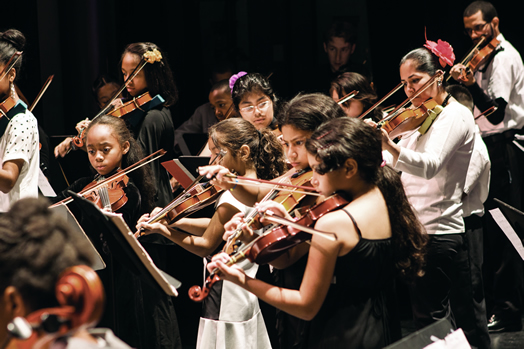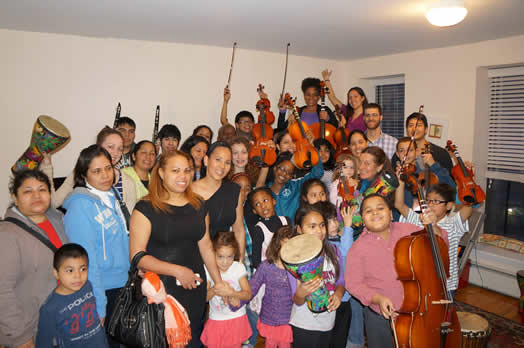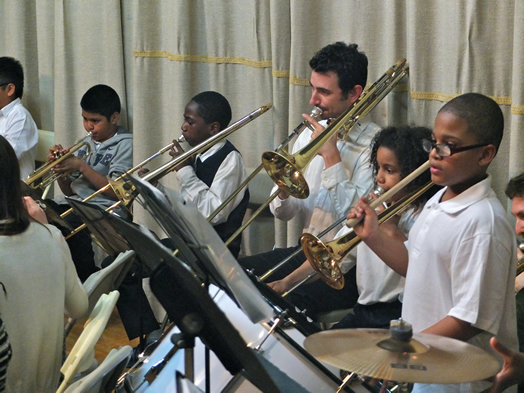Allegro
Sharing the Gift
A remarkable music education program from Venezuela spreads its inspiration to NYC
Volume 114, No. 7July, 2014
“Music has to be recognized as an agent of social development in the highest sense, because it transmits the highest values – solidarity, harmony, mutual compassion. And it has the ability to unite an entire community and to express sublime feelings.”
– José Antonio Abreu

Upbeat NYC. (Photo: Illir Bajraktari)
The importance of providing arts education – including music – for our children is immeasurable. And until recently, music education was accessible to every public school student in the United States. Sadly, this is no longer true. With the erosion of arts education, many parents are forced to find alternatives if they want to expose their children to music lessons. The good news is that free or low-cost options do exist. Local youth orchestras such as the New York Youth Symphony provide free instruction for highly-talented, well-trained students. The newly formed National Youth Orchestra, organized by Sir Clive Gillison at Carnegie Hall, auditions the crème de la crème of music students from around the country to perform and tour with different international conductors, again free of charge for the students.
But both of those youth orchestras are geared to students with families who understand the importance of music education and who also have the resources to give their children every opportunity available. Many kids don’t have those same advantages, but they still deserve the chance to learn music. There is an alternative for these students – youth orchestras based on the El Sistema model.
In 1975, José Antonio Abreu, a Venezuelan economist and musician, had a vision – a regional youth orchestra for underprivileged children from the inner cities of South America. Abreu believed that his orchestra would not only be a shining example of the formative power of music, but could eventually initiate social change. His vision was realized when he formed the Simón Bolívar Youth Orchestra, made up of children from the urban slums of Venezuela. And so began “El Sistema” (which means “The System” in Spanish).

CHILDREN ARE THE FUTURE: Neighborhood kids get the opportunity to learn music at Upbeat NYC. (Photo: Liban Gomez)
Skepticism abounded. How could a group of poor, urban children possibly play sophisticated orchestral music, let alone change society? Validation for Abreu came after his youth orchestra won a prestigious international competition in 1977 in Scotland. The facts spoke for themselves. Aside from the outstanding musical accomplishment of the orchestra, the children – who otherwise might have dropped out of school and potentially entered into a life of crime – began to excel in their academics. Coincidentally, there was a noticeable dropoff in the juvenile crime rate. Both the government and banks realized that for every dollar they contributed, they were getting approximately $1.68 in return – not a bad investment. From that point forward, the Venezuelan government began to fully fund Abreu’s orchestra.
Today, there are 125 youth orchestras in Venezuela – all part of El Sistema – but the Simón Bolívar Youth Orchestra remains the country’s most renowned. Its current music director is Gustavo Dudamel, who graduated from the youth orchestra, then went on to become the conductor of the Los Angeles Philharmonic, a post he still holds. He remains fiercely committed to the concept that music can bring about social reform, and despite an enormously busy schedule, he continues to conduct and tour with his native youth orchestra. Here, in the greater New York area, there are several schools inspired by El Sistema. One prominent organization is the Harmony Program, directed by Anne Fitzgibbon, which serves Manhattan, Brooklyn and Long Island. Another is UpBeat NYC, directed by Liza Austria and husband Richard Miller, which focuses on the South Bronx. Each remains true to José Antonio Abreu’s philosophy of providing free instruments and classical music training to children in marginalized urban communities.
The Harmony Program’s Anne Fitzgibbon spent a year in Venezuela under a Fulbright scholarship, immersing herself in El Sistema. As she put it, “It changed my life.” Harmony is a well-structured organization that sends professional musicians off-site five days a week, providing after-school music lessons to public school children in grades three, four and five. The kids get two hours of orchestra rehearsal and group instrumental instruction. But her vision goes beyond music lessons alone.

Learning the trombone at the Harmony Program.
Fitzgibbon explained to us, “Ours is primarily a three-year program. Once the students graduate and move to middle school, we try to connect them to other opportunities to keep them playing or provide them a permanent home in our Saturday orchestra program.”
It is clear that Harmony wants to nurture these children as much as possible, creating a broader framework with lifelong benefits.
Angela Shankar and Daniel Linden are both Local 802 musicians who work with the Harmony Program, teaching students at PS 129 in Harlem.
Linden spoke passionately about the program. “It feels vital,” he said. “I live in Washington Heights and I wanted to be part of that community and do something substantial in a rigorous musical program. The Harmony Program affords me and the students that opportunity.” When Shankar was asked why she wanted to work with the Harmony Program, she told us, “I’ve always done a lot of teaching. When I was in Rochester I started a mentorship program called Pathways, pairing underserved children with music instructors at Eastman for free clarinet lessons. When I came to New York and learned about the Harmony Program, I knew I had to be a part of it. It’s very special.”
Harmony wants to nurture the teachers as well. They provide 20 to 25 hours of professional development and ongoing training sessions for its teachers throughout the school year. Shankar said, “There can be many challenges in this type of program and Harmony is there, supporting us at every step.”
UpBeat NYC has a more home-based approach. Liza Austria’s father was a prominent bass player and Local 802 member. Jaime Austria, who died in 2010, became deeply inspired by El Sistema. It was the subject of many family conversations. Liza Austria felt it was important to carry on her father’s legacy and in 2009 started UpBeat NYC with her mother, brother and husband in the South Bronx. There, they have brought the gift of music to the children of this predominantly Latino neighborhood.
UpBeat NYC keeps everything close to students’ homes. Space is donated from neighborhood schools and churches where predominately volunteer teachers work with 110 children multiple times per week. The kids range in age from 5 to 21. The organization hopes to have its own facility one day that will enable it to work with even more children.
For Austria, it’s as much about building community as it is about the music.
“We want to open the hearts and minds of children through the power of music,” she told us. “But we also want to build a strong community.”
That means not only engaging the neighborhood children, but their parents and family members as well.
“Initially, many students came to us from the street with no parental involvement,” Austria explained. “Now, parents help get each other’s kids to and from lessons and attend workshops to learn how to assist their children with at-home practice.”
It’s clear from the successes of El Sistema in both Venezuela and New York that when children are given the gift of music, they thrive. And the more we can take part in this process, the more we can accomplish great things. For instance, as this article was going to press, a remarkable concert had just taken place at the United Palace Theatre in Washington Heights. The performance was a collaboration of six area programs all inspired by El Sistema, including the two mentioned in this article. It brought together all the children for one giant orchestral celebration. The excitement, joy and sense of possibilities were endless. A symphony or an opera in and of itself cannot change the world, but those who listen to it, play it and are affected by it, can. With music, there is hope for the future.
WANT MORE INFORMATION?
- Harmony Program – www.harmonyprogram.org
- Upbeat NYC – www.upbeatnyc.org
